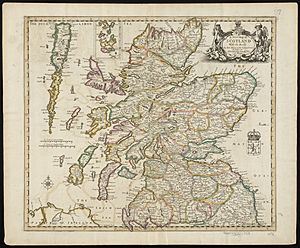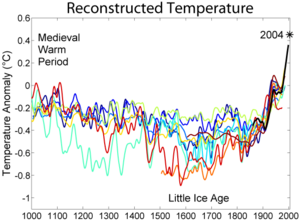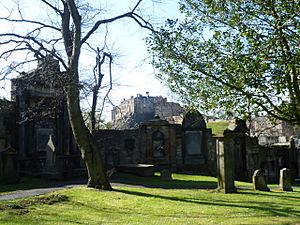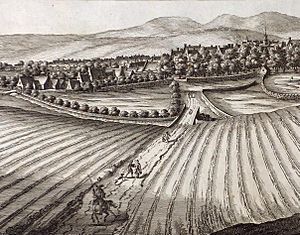Seven ill years facts for kids
The Seven Ill Years, also known as the Seven Lean Years, was a time of terrible hunger and food shortages in Scotland during the 1690s. It got its name from a story in the Bible about a famine in Egypt. Many people died from starvation during this period, with estimates suggesting between 5% and 15% of Scotland's population perished. In some areas, like Aberdeenshire, as many as 25% of people might have died. This famine is well remembered because it was the last major one of its kind in Scotland.
Scientists who study tree rings have found that the 1690s was the coldest decade in Scotland for 750 years. This very cold weather led to bad harvests in 1695, 1696, 1698, and 1699. At the same time, a big war called the Nine Years' War caused economic problems. These two things together led to the severe famine and a big drop in the number of people living in Scotland.
The old system for helping the poor in Scotland couldn't handle such a huge crisis. While towns probably had better support, the countryside suffered greatly. Many people had to move from their homes to find food. Some even left Scotland for England, Europe, America, and especially Ireland. This crisis also led to the creation of the Bank of Scotland and the Company of Scotland. When the Company of Scotland's big plan, the Darien scheme, failed, it pushed Scotland closer to joining with England, which happened in 1707.
What Caused the Famine?
Before the mid-1600s, Scotland's rough land, bad roads, and simple transport meant that different areas didn't trade much food. People mostly ate what was grown nearby. This started to change after 1660, with more towns holding markets. However, extra food was often sold to other countries, like cattle to England. For different reasons, farming in Scotland wasn't as good as it could have been, and this problem lasted into the 1700s.
Most small communities relied on their own local food. They often had very little extra food saved for bad years. Most farming happened in small groups of families called fermtouns or bailes. These families worked together to farm an area. They shared the land using a system called run rig, where they took turns farming different strips of land.
Different people had different roles in farming. Some owned land, like husbandmen and free tenants. Below them were cottars, who had small plots of land and worked for others. There were also grassmen who only had rights to graze animals. Many people worked for wages. Those with fixed incomes, like pensioners, were hit hardest by the famine. Even farmers with land struggled to save enough seeds for the next year and feed their families. Animal farmers also suffered because animal feed became too expensive.
The 1690s marked the end of good economic times that had been around since 1660. After 1689, Scotland joined the Nine Years' War. This war caused trade to slow down with important markets in the Baltic Sea area and France. Then, harvests failed in 1695, 1696, 1698, and 1699. The famine was widespread across Scotland from 1694 to 1699, though some areas were affected for shorter times. These bad years followed other poor harvests in the 1680s, and the problems didn't fully end until after 1700.
Across Europe, the 1690s were the coldest part of the Little Ice Age. This was a long period of colder and wetter weather that started in the 1400s. The cold weather meant crops couldn't grow as high up mountains, and the growing season became shorter by up to two months in some years. Huge volcanic eruptions in Iceland (1693) and Indonesia (1693 and 1694) might also have filled the air with ash, blocking out a lot of sunlight.
How the Famine Affected People
The cold weather led to rising prices, severe hunger, and a drop in population, especially in northern Scotland. People who lived through it said that many died from starvation. Local managers reported that from 1695 to 1697, "many people starved to death for want, both in town and country." In 1698, reports reached Edinburgh of people found dead on roads across the country. That same year, the price of oatmeal, a main food in Scotland, went up by 166% in Aberdeen. Aberdeen was hit especially hard because it relied on trade with the Baltic Sea. People were so desperate they ate grass, nettles, and rotten meat to survive.
Estimates suggest that 5% to 15% of the total population died from starvation. But in places like Aberdeenshire, this number might have been as high as 25%. Young children, older people, and widows were most at risk.
The famine caused a quick rise in the number of very poor people and homeless wanderers. These people traveled the roads looking for work, help, and food. In 1698, a man named Andrew Fletcher of Saltoun guessed that about one-sixth of Scotland's population, around 200,000 people, had left their homes to beg. This was double the usual number of homeless people in non-crisis years. Many moved within their local areas to keep getting help from the poor relief system. However, many families later moved to bigger towns and even to other countries, especially England and Ireland.
So many poor beggars arrived in Edinburgh in December 1696 that the town council had to set up a "refugee camp" in Greyfriars kirkyard to house them all. Other towns reacted by giving harsh punishments to beggars.
The old system for helping the poor in Scotland was completely overwhelmed. In the countryside, where most people lived, help came from the local church group, called the kirk session. This group was usually led by the minister and relied on rich local landowners. The role of the minister was weakened because many had been removed from their jobs after a political change in Scotland, and new ones had not been found by the time of the famine.
In towns, there were more ways to help the poor. Besides church groups, there were guilds (groups of skilled workers), trade societies, and town councils. Town councils could also step in to try and keep food prices low when food was scarce. The famine's impact might have been worse in towns because the arrival of many starving people brought outbreaks of diseases like smallpox.
Why the Famine Was Important
These problems weren't only in Scotland. From 1695 to 1697, there was also terrible hunger in places like Estonia, Finland, Latvia, Norway, and Sweden. About two million people died in France and Northern Italy. The Scottish famine is important because famines had become quite rare in the second half of the 1600s. This was the last major famine of its kind in Scotland.
The conditions led to some people moving between different farms and local areas in Scotland. Moving to England was difficult because English laws stopped help for strangers. Other parts of Europe had similar problems. The famine might have been a reason why some Scots moved to the American colonies and the West Indies as indentured servants (people who worked for a period to pay for their travel). This became the most common way Scots moved across the Atlantic during this time.
From 1650 to 1700, about 7,000 Scots moved to America, 10,000 to 20,000 to Europe and England, and 60,000 to 100,000 to Ireland. About 20,000 Scots moved to Ireland between 1696 and 1698. This was because land became available there after a war ended in 1691.
To fix the terrible economic situation, the Scottish Parliament passed new laws in 1695. These laws allowed farmers to combine their run rig strips of land and divide common land. These changes helped improve Scottish farming greatly in the 1700s. They made farming much more productive, ensuring people could be fed even in very bad conditions, even as the population grew.
Other important changes included the creation of the Bank of Scotland. Also, the Company of Scotland was set up to trade with East Asia. This company raised money from the public. The Company invested in the Darien scheme, a big plan to build a colony in Panama for trade. About 15% to 40% of all the money available in Scotland was invested in this project. But the plan failed in 1700. Only 1,000 of 3,000 colonists survived, and only one ship returned. The loss of £150,000 put a huge strain on Scotland's economy. This failure was a key reason why Scotland and England joined together in 1707 to form the Kingdom of Great Britain.





